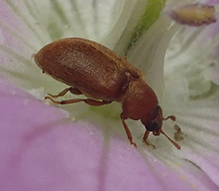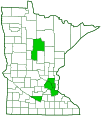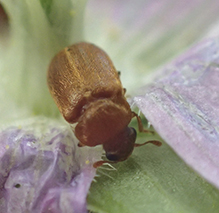raspberry fruitworm beetle
(Byturus unicolor)
Conservation • Description • Habitat • Ecology • Distribution • Taxonomy
|
|
||||||||||||||
Description |
Raspberry fruitworm beetle is a common, small, early season, fruitworm beetle. In the United States there are two widely separated (disjunct) populations. In the east, it occurs from Maine to northern Georgia, west to Minnesota and eastern Texas. In the west it occurs in Washington, northern Oregon, and Idaho. It also occurs across southern Canada and in Alaska. The two populations were formerly treated as separate species, the eastern as Byturus rubi, and the western as Byturus bakeri. They were united as Byturus unicolor in 1983. Raspberry fruitworm beetle is found on brambles (Rubus spp.), avens (Geum spp.), and wild geranium. The larvae feed on the fruits and developing flowers. Adults are active from April to June. They feed on the leaves and flowers. Raspberry fruitworm is a pest of cultivated raspberries. Adults feed voraciously on the emerging leaves, creating many elliptical holes in the foliage. Their feeding sometimes causes developing bud clusters to be aborted. The larvae feed on the fruit, creating dry, decaying berry drupelets. The size of this small beetle is usually given as ⅛″ to 3 ⁄16″ (2.7 to 4.8 mm) in length, but that is from the front margin of the thorax (prothorax) to the rear of the wing covers (elytra), and it does not include the head. The body is oblong and somewhat convex. It is usually yellowish brown to reddish brown to blackish, without contrasting markings, and it is moderately to densely covered with long reclining hairs (setae). The head is wider than long. It is inserted into the thorax up to the rear margin of the eyes. The eyes are large and egg shaped. The mouthparts are directed downwards. The antennae have 11 segments. The last three segments are expanded, forming a prominent club. The plate on the upper side of the prothorax (pronotum) is wider than long. The front is wider than the head and the rear is almost as wide as the base of the elytra. The elytra are straight sided. Each elytron has ten weak ridges. Each ridge has a single row of fine pits (punctures), and each puncture has a single seta. The spaces between the ridges have one or two rows of larger punctures, each with a single seta. On each leg the third segment (femur) is slightly swollen, and the fourth segment (tibia) is slender. The last part of each leg (tarsus), corresponding to the foot, has 5 segments. Segments 2 and 3 have broad lobes below, segment 4 is very small, and segment 5 has two claws at the tip. The claws are equal in length and have a large tooth at the base. |
Size |
Total length: ⅛″ to 3 ⁄16″ (2.77 to 4.75 mm) |
Similar Species |
Habitat |
|
Ecology |
Season |
One generation per year: April to late June |
Behavior |
Adults are most active in the early morning and early evening. |
Life Cycle |
The female lays single eggs on or near buds, flowers, or developing fruit. The larvae feed on or in the base of the flower (receptacle) or the fruit. In late summer they emerge and drop to the ground. They overwinter in the soil as pupae. Adults emerge in mid-April to mid-May when the leaves begin to unfold. They feed on the emerging leaves. |
Larva Hosts |
Brambles (Rubus spp.), avens (Geum spp.), and wild geranium. |
Adult Food |
Leaves and flowers |
Distribution |
||
|
Sources A revision of the family Byturidae (Coleoptera) for North America Charles A. Springer and Michael A. Goodrich. 1983. The Coleopterists Bulletin, Vol. 37, No. 2, pp. 183-192. |
|
| 3/22/2024 | ||
Occurrence |
||
|
||
Taxonomy |
|
Order |
Coleoptera (Beetles) |
Suborder |
Polyphaga (Water, Rove, Scarab, Long-horned, Leaf, and Snout Beetles) |
Infraorder |
Cucujiformia |
Superfamily |
Cleroidea (bark-gnawing, checkered, and soft-winged flower beetles) |
Family |
Byturidae (fruitworm beetles) |
Genus |
Byturus |
This is the only species in the genus Byturus that occurs in North America. |
|
Subordinate Taxa |
|
|
|
Synonyms |
|
Byturus bakeri Byturus rubi Byturus sordidus |
|
Common Names |
|
common raspberry fruitworm eastern raspberry fruitworm raspberry fruitworm (larva) raspberry fruitworm beetle (adult) western raspberry fruitworm |
|
Glossary
Elytra
The hardened or leathery forewings of beetles used to protect the fragile hindwings, which are used for flying. Singular: elytron.
Femur
On insects and arachnids, the third, largest, most robust segment of the leg, coming immediately before the tibia. On humans, the thigh bone.
Pronotum
The exoskeletal plate on the upper side of the first segment of the thorax of an insect.
Prothorax
The first (forward) segment of the thorax on an insect, bearing the first pair of legs but not wings.
Punctate
Dotted with pits (punctures), translucent sunken glands, or colored spots of pigment.
Seta
A stiff, hair-like process on the outer surface of an organism. In Lepidoptera: A usually rigid bristle- or hair-like outgrowth used to sense touch. In mosses: The stalk supporting a spore-bearing capsule and supplying it with nutrients. Plural: setae. Adjective: setose.
Tarsus
On insects, the last two to five subdivisions of the leg, attached to the tibia; the foot. On spiders, the last segment of the leg. Plural: tarsi.
Tibia
The fourth segment of an insect leg, after the femur and before the tarsus (foot). The fifth segment of a spider leg or palp. Plural: tibiae.
Visitor Photos |
||
Share your photo of this insect. |
||
This button not working for you? |
||
Babette Kis |
||
Byturus unicolor raspberry fruitworm beetle Byturus unicolor, raspberry fruitworm beetle, on wild geranium, Barnes Prairie, Racine Co., WI. A very small beetle, often overlooked, but it can be quite abundant on wild geranium. |
||
Byturus unicolor Barnes Prairie May 31 2021 |
||
Byturus unicolor on wild geranium Barnes Prairie, Racine Co., WI May 30, 2022 |
||
MinnesotaSeasons.com Photos |
||
|
||
|
||

Slideshows |
|

Visitor Videos |
||
Share your video of this insect. |
||
This button not working for you? |
||
|
Other Videos |
||
RASPBERRY FUITWORM BEETLE preening. Byturus unicolor |
About
ul 26, 2017 Byturus unicolor = RASPBERRY FUITWORM BEETLE preening or cleaning itself. Busse woods FP, IL 6/24/2017. |

Visitor Sightings |
||
Report a sighting of this insect. |
||
This button not working for you? |
||
Babette Kis |
Location: Barnes Prairie, Racine Co., WI. Byturus unicolor Barnes Prairie May 31 2021 |
 |
Babette Kis |
Location: Barnes Prairie, Racine Co., WI. Byturus unicolor on wild geranium Barnes Prairie, Racine Co., WI May 30, 2022 |
 |
MinnesotaSeasons.com Sightings |
||
|

Created: 3/22/2024 Last Updated: © MinnesotaSeasons.com. All rights reserved. |


